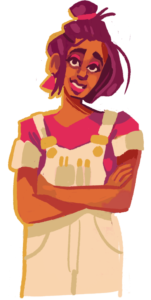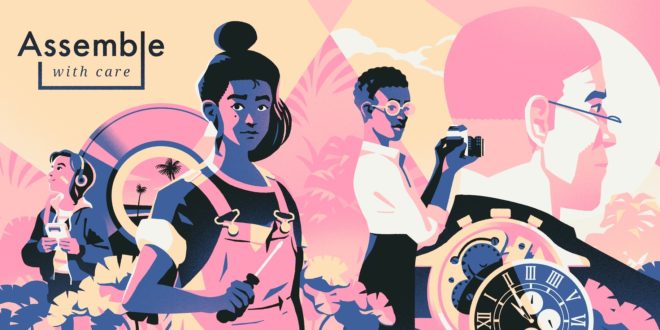It’s rare to be in a games studio at the very moment that a game is released – such press junkets are usually done well before the nitty gritty of release day, but here we are in Ustwo’s achingly-cool south London hideaway, as the team are seeing their game’s very first reactions go up live on Twitter, the result of some users getting access to Apple Arcade a couple of days early.
Despite that, Chief Creative Officer Dan Gray is a very happy man: “I’m excited to be able to talk about the game, rather than keeping everything under wraps, and excited that thing isn’t Monument Valley.’’
“I love Monument Valley but it’s been two years waiting for something new to talk about and now’s finally the time.”
Ustwo were very much the Monument Valley people, with the studio’s reputation being built around that title and its sequel: “we knew we could have been that company that made Monument Valley games forever, there’s an appetite out there for us to do that, and we will make another Monument Valley game at some point, but the most important thing to us was to create a new story, a new experience that was going to surprise people in a completely different way.”
That new experience is Assemble with Care and here Gray turns the tables, asking us: “If you played the game, do you think that you’d get a jist it was by us?”
MECHANICAL MARVELS
The short answer to that is “no”. Assemble with Care is most definitely not a direct successor to the studio’s mega hit. It’s a narrative-driven game where you take the role of Maria, a young woman who travels around repairing and restoring others cherished possessions. Storybook sections alternate with puzzles, where you need to dismantle, repair and reassemble a wide variety of different objects from cameras to statuettes, watches to slide projectors.

That said, you can clearly see its heritage, once you’re aware of the connection. There’s a pleasing solidity and tactile sense to both Assemble’s objects and Monument Valley’s architecture. The studio continues to value quality over quantity: There aren’t many press events where you can realistically finish the entire game between arriving and your interview slot. Additonally, similar to Monument Valley, the game is not what you’d call challenging.
One, less tangible link, is in the theme of familial relationships, which also sat at the heart of Monument Valley 2. Assemble with Care uses the repair of objects as a proxy to help Maria repair relationships, both between a daughter and a father, and between two sisters. Or as Gray puts it: “Fixing the physical with tools you understand, but also fixing the emotional with tools we all struggle with on a day-to-day basis.”
Many of the items are everyday, prosaic bits of kit, but they’re priceless to their owners, such as a child who has a tape deck to listen to a recording of her departed mother’s voice.
“One thing that was important to us was this idea of empathy and understanding between different groups of people,” Gray continued. “There’s a very polarising way of being at the moment, where people sit on either side of their fence. This game is about trying to help people understand the position of another person.”
With characters, a storyline and all those items to repair, Assemble is far more grounded than Monument Valley. It’s a love letter to the 80s, to a time when mechanical items were still worth fixing, that makes it potentially less universal in its appeal than its surreal predecessor. But personally, we found it immensely charming in a kitschy, romantic way.
A GUIDING LIGHT
Senior game designer Joel Beardshaw explains that the team is largely “of an age between their mid-twenties to late 30s,” and that this informed its choices when it came to the 80s setting and the items selected for Maria to repair.

“These are things that we grew up with, things that we’re nostalgic for, a lot of the objects were chosen because people had a little story about them, an idea that came from their childhood or finding something and reminiscing about it.”
In our talk, Gray and Beardshaw speak often about how the game was a collaborative effort by the whole team: “They’re not just personal to one person but are personal to the team, lots of shared stories in the team,” says Beardshaw.
Gray later reaffirms this, saying that there’s no single auteur on the game: “‘It’s more like how do we get a group of people really excited, really on board and really aligned with making a thing. It’s certainly not ‘everyone make my thing.’”
Beardshaw provides us with an example of an item from early in the game: “We all knew we wanted to have a camera in it, that idea of a mechanical camera is something that’s kind of gone away, but it’s so interesting to know what’s inside.”
Now many of us know how a single lens reflex camera works, so pulling one apart and adjusting the mirror to bounce the light as intended is pretty straightforward. But for others, notably younger players, it will be a very new concept.
“That’s part of the charm,” Gray replies, adding that ”one of the unexpected but beautiful things about Monument Valley is that yes, they are single player experiences technically, but the amount of people who play the games together, as a guided experience, is huge,” and Assemble definitely has a storybook feel that works well for bedtimes.
Even without prior knowledge of the items, the game worked universally in testing. For example, whether players were familiar with tightening an audio cassette tape using a pencil. “That is something we’ve use-tested for a lot, we asked ‘did you have a tape deck when you were a kid? Did you do this?’”
SHIPPING IT
For every item that made it into the game, many more missed out, Beardshaw explains: “There were lots of objects left behind: this is too similar to that one. Does it serve a narrative purpose? Does it tell you anything about that character?”
And that’s just the beginning of the requirements, Beardshaw notes: “What’s an interesting object, which uses the right mechanics, that is going to facilitate the right amount of complexity for that point in the game, that’s roughly this size and shape [as it has to fit onscreen after all]? It was so difficult to make levels, in an interesting way, an interesting challenge.”
“So for example, we really wanted to do a ship in a bottle. But It didn’t quite fit with the set of characters we had, because every level needs to progress that character’s relationship in some way. But Maria, she’s a restorer by trade and she travels around places, there’s no reason why we can’t have her meet somebody else, where that item does make sense,” Beardshaw notes, suggesting a possible sequel or expansion. The pair jokingly come up with some possible names before Gray settles on “More Assembly required!”

The team had a giant “cool wall” full of items for the game, covered with A5 sheets with photos and descriptions of every object. Letting everyone see and comment on what was under consideration in a more democratic fashion: “It was half bonding exercise and half discovery of what the game is – trying to decide what the core objects that this game is going to be about. When you first have this idea of taking things apart and putting them back together and telling stories about characters through their objects, there’s a lot that comes out of that discussion” says Beardshaw.
In order to get everyone involved, Ustwo was keen to keep the team size down on both Assemble and the other (unannounced) title which is still in development, Gray tells us.

“We were eight people when we made Monument Valley 1, and there were 16 dev members of Monument Valley 2 and then we scaled down for these games. So we’ve had maybe 12 people work on Assemble with Care. We made the team a little bit smaller because we’re all about making games that feel personal, so that they feel made by a small group, almost handcrafted in a way.”
“The team that started it was the Monument Valley 2 people and then more people came on and more junior roles came in and people who are fresh to the company joined. If you want stuff to feel personal, the best way to freshen things up again, and again and again is to have different personal influences on it.”
WE GOT OURSELVES A READER
As Gray has mentioned Monument Valley, we feel safe to ask about the connections between the games one more time. So was it a conscious decision that the team made a big shift away from that title with Assemble?
 “We wanted to do something completely different,” he states, but says that they still wanted to attract the same kind of audience: “I think it will do, I think this is a really good experiment in making something grounded, more relatable.”
“We wanted to do something completely different,” he states, but says that they still wanted to attract the same kind of audience: “I think it will do, I think this is a really good experiment in making something grounded, more relatable.”
With years work behind the game, a lot of testing, plus the incredibly engaging final result, it’s surprising to hear Gray call Assemble with Care an experiment.
“Everything we make is going to be a risk, that’s the whole point. We spent about a year prototyping, going from sixteen different ideas, down to ten, down to six, then from six to three,” he pulls a pained expression, “and then three finally went down to two, and so we’re currently working on two games here.”
Some might presume that Assemble was among the least risky of those ideas, but Gray scotches that idea: “I would say that safety is not the number one criteria of why ideas for our games get chosen.” To which Beardshaw adds: “It’s the excitement in the room.”
Gray agrees: “A great game is made by people who were excited to make it, you could take an idea that seems a little bit safer, a little bit more stable and a bit more of a known quantity.
“But if the team aren’t ten-out-of-ten infused by it, you’re not going to end up with a great game. So we can take something that’s a little bit more risky and trust and rely on the people in the team to bring it up a couple of notches.
“This is an interactive story with puzzle elements, and it is risky to ask people to read text in any capacity!” Gray exclaims.
“That is a risk. But we believe it’s a risk worth taking because we truly believe that people are going to engage with the story and relate with the characters in it. People can relate with Ida in Monument Valley to a certain extent but do they relate with having a disconnect with one of their children in the same way?”
“It is a risk. It’s a risk because we think that people are going to resonate with these relationships stronger than other things.”
NO SHOPPING ARCADE
But maybe Assemble with Care can afford to take risks, because no one will be directly paying to play the game, an unusual shift for the makers of one of the biggest-selling ‘premium’ mobile games of all time. That’s because Assemble is among the first wave of titles to be launched on Apple Arcade, the much-hyped saviour of the ‘premium’ game segment.

“We’ve got a tweet on our wall which is a review from someone saying: ‘I just want to say thank you for this beautiful experience you’ve provided for me, it’s one of the most memorable things I’ve played on my device – I only wish it wasn’t three dollars and 99 cents.’”
It’s not untypical either, just look at the huge number of glowing, gushing even, reviews for Monument Valley and even the most enthusiastic fans still seem to be irked by an apparent lack of value for money. They all feel there should have been more of the game, to which Gray replies rightly: “A six hour long Citizen Kane would not be a better movie.” Apple Arcade removes that financial burden, or at least the user’s perception of it.
“There’s no direct value attributed to individual games,” notes Gray. “So we are definitely going to see people who play our game and just love it. They’re not going to think about the financial transaction. And that’s brilliant.”
“People are looking at [subscription services] as a way to provide safe experiences for the family. People want to get away from things like loot boxes in their games. So for us that’s beneficial because we get a whole bunch of people who would never have paid for one of our games in a premium sense. People who are now going to get to experience the things that we do.”
And he’s not worried about the competition from the mass of launch titles on the service on day one: “With all these games that are going to come out [on Apple Arcade], there is going to be lots explosions, action, skateboarding, all this kind of stuff. I think it’s going to be really interesting, and I’m actually really proud of the fact, that something like ours is going to be talking to normal people.”
“Maybe these things are different for the free-to-play games and for a lot of the more commercially driven companies, but for people who create experiences our size, it doesn’t feel like a competition. At the end of the day the more quality experiences that sit alongside Assemble with Care, the better. What’s that saying? A rising tide lifts all boats!”
“Day one, when the game goes live, it’s not going to have the biggest install base in the world. But compared to a lot of the stuff that’s launching, it’s going to be so much more of a slow burn. There’s still people who are picking up on and watching Orange is the New Black on Netflix now. I think that is what’s going to happen here.
“The early adopters are going to probably be a lot of tech and game enthusiasts. But as time goes on we’re only going to get stronger. So I do think that success for this is going to come as a long burn thing over the course of the next three years, as the audience of Apple Arcade gets bigger.
Of course, Ustwo isn’t at liberty to discuss the details of its deal with Apple, and only time will tell if the service can kickstart a golden era for high-quality mobile games without free-to-play monetisation. Based on the flak the industry is receiving at present, be that fully justified or not, the service has certainly come along at a great time to help paint a better picture for the games industry as a whole.
TOO COOL FOR SCHOOL
Assemble with Care is a long way off the stereotypical core of the games industry. It’s exactly the kind of game that you can show any critic of the industry, to explain that it all can’t simply be lumped together as violently competitive, microtransaction-driven, service games.
Beardshaw tells us: “We’re trying to make games for people who don’t know what’s great about games or those who are just put off by certain aspects of what can be found in vast swathes of games.” Which is an attitude the industry could use a lot more of.
Beardshaw and Gray aren’t just some pair of design gurus who dislike the core market. Both of them have solid industry credentials, having worked on titles as varied as Joe Danger and No Man’s Sky (Gray), and Fifty Cent: Blood in the Sand and Operation Flashpoint (Beardshaw).
“We’re trying to take what’s amazing about video games, what we all get to experience when we play on our console or PC, and deliver some of those amazing things to people who play mobile games, because for the most part, casual players play what we consider to be a quite small subsection of what is possible within video games.” Gray points out.
The team at Ustwo Games could make a game with spaceships, guns, tanks and a pounding hip-hop soundtrack, they’ve just chosen not to. And maybe you could choose not to as well. Ustwo is hiring, they’ve got loads more things that need assembling (with care), with Monument Valley 3 being just one of those things, so why take a leaf out of Maria’s book and take a more positive approach to fixing what’s wrong in the world. Who knows, maybe you could make something priceless too.

 MCV/DEVELOP News, events, research and jobs from the games industry
MCV/DEVELOP News, events, research and jobs from the games industry




